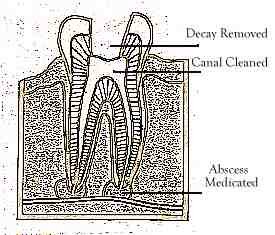The Palliative Stage
Palliative means to sooth or in the case of a painful tooth - to make painless. Once your dentist has diagnosed the tooth as having a dead or dying nerve and the decision is made to have root canal treatment, he or she will arrange for you to attend the surgery for at least three appointments. The first stage of the root canal, the pulpectomy, can be done first at the initial appointment in order to relieve you of any discomfort.
It is essential that you keep all your appointments as any delay may cause a recurrence of the symptoms and may adversely affect the success of the root canal treatment. It is also important that you take, as directed, any medicines prescribed (usually painkillers and antibiotics).
 Initially, your tooth is made comfortable by a local anaesthetic, numbing it. Then, a sheet of rubber, called a rubber-dam, is placed in the mouth isolating the tooth. This usually done before a hole is made to access the pulp chamber within the tooth. This prevents saliva and bacteria from entering the treatment area and there is evidence to show that this may help increase the success rate of treatment. Ask your dentist his reasons for NOT using a rubber-dam.
Initially, your tooth is made comfortable by a local anaesthetic, numbing it. Then, a sheet of rubber, called a rubber-dam, is placed in the mouth isolating the tooth. This usually done before a hole is made to access the pulp chamber within the tooth. This prevents saliva and bacteria from entering the treatment area and there is evidence to show that this may help increase the success rate of treatment. Ask your dentist his reasons for NOT using a rubber-dam.
 The tooth is then thoroughly cleaned out. The pulp chamber and root canals are cleaned and any dead tissue is removed. Your dentist may use an antibacterial solution in a syringe to thoroughly cleanse the cavity - don't worry this is NOT an injection. Any decay is removed and the tooth is then medicated and sealed with a temporary filling. This kills off any residual bacteria and prevents saliva and bacteria from entering the tooth during the interval between this appointment and the next.
The tooth is then thoroughly cleaned out. The pulp chamber and root canals are cleaned and any dead tissue is removed. Your dentist may use an antibacterial solution in a syringe to thoroughly cleanse the cavity - don't worry this is NOT an injection. Any decay is removed and the tooth is then medicated and sealed with a temporary filling. This kills off any residual bacteria and prevents saliva and bacteria from entering the tooth during the interval between this appointment and the next.
An interval of time ranging from a few days to a couple of weeks is then allowed to pass to allow the tooth to settle down and any infection to start healing.
LINKS | TOPICS ONLINE | SEARCH | HOME